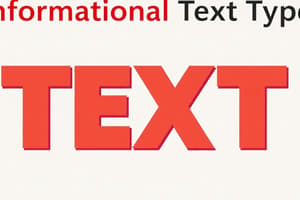Podcast
Questions and Answers
When analyzing an argumentative text, what is the primary goal in determining the author's point of view?
When analyzing an argumentative text, what is the primary goal in determining the author's point of view?
- To critique the author's writing style and use of rhetorical devices.
- To identify the author's personal biases and emotional state.
- To understand the author's stance, assumptions, and potential counterarguments. (correct)
- To summarize the author's main points and supporting evidence.
How does the process of determining point of view differ between literary texts and informational texts?
How does the process of determining point of view differ between literary texts and informational texts?
- The point of view is irrelevant in informational texts as they primarily focus on factual accuracy.
- Literary texts often employ narrative perspectives to shape the reader's experience, whereas informational texts aim for objectivity. (correct)
- Informational texts rely on emotional appeals to convey the author's viewpoint, whereas literary texts focus on logical reasoning.
- In literary texts, the point of view is always explicitly stated, while in informational texts, it is implied.
Which of the following best describes the role of point of view in shaping a reader's understanding of a literary text?
Which of the following best describes the role of point of view in shaping a reader's understanding of a literary text?
- Point of view limits or expands the reader's access to characters' thoughts, feelings, and motivations. (correct)
- Point of view primarily affects the pacing and structure of the narrative.
- Point of view dictates the level of emotional engagement the reader experiences.
- Point of view determines the text's genre and intended audience.
What consideration is most important when evaluating the credibility of an author's point of view in an informational text?
What consideration is most important when evaluating the credibility of an author's point of view in an informational text?
How might understanding all three types of texts (literary, informational, and argumentative) contribute to a more comprehensive analysis of a given subject or issue?
How might understanding all three types of texts (literary, informational, and argumentative) contribute to a more comprehensive analysis of a given subject or issue?
Flashcards
Point of View
Point of View
Understanding a story through the narrator's eyes.
Reading Literary Texts
Reading Literary Texts
Engaging with stories, poems, and dramas for their artistic and expressive qualities.
Reading Informational Texts
Reading Informational Texts
Analyzing texts that aim to present facts, explain concepts, or provide information.
Reading Argumentative Texts
Reading Argumentative Texts
Signup and view all the flashcards
Author's Point of View
Author's Point of View
Signup and view all the flashcards
Study Notes
- Literary texts, informational texts, and argumentative texts each serve distinct purposes and employ different strategies to engage the reader.
- Understanding the nuances of each type is essential for effective reading comprehension and critical analysis.
- Point of view is a critical aspect of all three text types, influencing how information is presented and interpreted.
Reading Literary Texts
- Literary texts encompass a wide range of creative works, including novels, short stories, poems, and plays.
- The primary purpose is often to entertain, evoke emotions, and explore the human condition through imaginative storytelling, character development, and thematic exploration.
- Literary texts often employ figurative language, symbolism, imagery, and other literary devices to create deeper meaning and aesthetic appeal.
- Reading literary texts requires attention to detail, sensitivity to language, and an ability to interpret underlying themes and messages.
Key Features of Literary Texts
- Narrative structure: Literary texts typically follow a narrative structure, presenting a sequence of events that unfold over time.
- Character development: Characters are central to literary texts, and their thoughts, feelings, and actions drive the plot forward.
- Theme: Literary texts often explore universal themes, such as love, loss, identity, and morality.
- Figurative language: Metaphors, similes, personification, and other figures of speech are used to create vivid imagery and enhance meaning.
- Symbolism: Objects, characters, or events may represent abstract ideas or concepts.
- Tone and Mood: The author's attitude toward the subject matter and the overall atmosphere of the text contribute to its meaning and impact.
Strategies for Reading Literary Texts
- Pay attention to detail: Notice the author's word choice, sentence structure, and use of literary devices.
- Identify the main characters and their relationships: Understanding the characters' motivations and how they interact with each other is crucial.
- Analyze the plot: Follow the sequence of events and identify the key turning points.
- Interpret the themes: Consider the underlying messages and ideas that the author is trying to convey.
- Consider the context: Think about the historical, social, and cultural context in which the text was written.
Reading Informational Texts
- Informational texts aim to convey factual information and objective knowledge about a particular subject.
- Examples include textbooks, encyclopedias, news articles, scientific reports, and documentaries.
- Informational texts typically employ a clear and concise writing style, using precise language and avoiding emotional appeals or subjective opinions.
- The primary goal is to educate the reader and enhance their understanding of the topic at hand.
Key Features of Informational Texts
- Factual accuracy: Information presented is based on evidence and research.
- Objectivity: The author strives to present information without bias or personal opinion.
- Clear and concise language: Vocabulary is precise, and sentences are straightforward.
- Organization: Information is presented in a logical and structured manner.
- Use of evidence: Claims are supported by data, statistics, examples, and expert opinions.
- Visual aids: Charts, graphs, images, and diagrams are often used to illustrate concepts and data.
Strategies for Reading Informational Texts
- Identify the main idea: Determine the central point that the author is trying to convey.
- Take notes: Summarize key information and concepts as you read.
- Look for supporting details: Identify the evidence and examples that the author uses to support their claims.
- Evaluate the credibility of the source: Consider the author's expertise and the reliability of the information.
- Make connections: Relate the information to what you already know and to other sources you have consulted.
Reading Argumentative Texts
- Argumentative texts present a claim or thesis and provide evidence to support it, with the goal of persuading the reader to accept a particular viewpoint on a debatable issue.
- Examples include editorials, opinion pieces, debates, legal briefs, and persuasive essays.
- Argumentative texts often acknowledge opposing viewpoints and attempt to refute them, building a strong case for the author's own position.
- Rhetorical devices, such as appeals to logic, emotion, and ethics, are frequently used to persuade the reader.
Key Features of Argumentative Texts
- Clear thesis statement: Presents the author's main argument.
- Supporting evidence: Includes facts, statistics, examples, and expert opinions to support the thesis.
- Logical reasoning: Employs logical arguments to connect evidence to the thesis.
- Acknowledgment of opposing viewpoints: Addresses counterarguments and explains why they are invalid or less persuasive.
- Rhetorical devices: Uses persuasive language and techniques to appeal to the reader's emotions, ethics, or reason.
- Conclusion: Summarizes the main argument and reiterates the thesis.
Strategies for Reading Argumentative Texts
- Identify the thesis statement: Determine the author's main argument.
- Evaluate the evidence: Assess the quality and relevance of the evidence used to support the thesis.
- Analyze the reasoning: Identify any logical fallacies or weaknesses in the author's argument.
- Consider opposing viewpoints: Evaluate the author's treatment of counterarguments.
- Assess the author's credibility: Consider the author's expertise and potential biases.
- Form your own opinion: Based on your analysis, decide whether you agree or disagree with the author's argument.
Determining Point of View
- Point of view refers to the perspective from which a story or argument is told.
- It influences how information is presented, which characters' thoughts and feelings are revealed, and how the reader interprets events.
- Understanding point of view is crucial for comprehending the author's message and evaluating the credibility of the narrative or argument.
Types of Point of View
- First-person: The narrator is a character in the story and uses "I" or "we" to tell the story.
- Second-person: The narrator addresses the reader directly using "you."
- Third-person limited: The narrator is outside the story but only knows the thoughts and feelings of one character.
- Third-person omniscient: The narrator is outside the story and knows the thoughts and feelings of all the characters.
- Objective: The narrator does not reveal any characters' thoughts or feelings, only reports what is seen and heard.
Identifying Point of View
- Look for pronouns: Pay attention to the pronouns used by the narrator (I, you, he, she, it, we, they).
- Consider the narrator's knowledge: Determine how much the narrator knows about the characters and events in the story.
- Analyze the narrator's tone: Identify the narrator's attitude toward the characters and events.
- Think about the effect on the reader: Consider how the point of view influences your understanding and interpretation of the story.
The Impact of Point of View
- Point of view shapes the reader's understanding of the characters, events, and themes in a text.
- It can create empathy, distance, or bias, depending on the narrator's perspective.
- Authors choose point of view strategically to achieve specific effects and to convey their intended message.
Studying That Suits You
Use AI to generate personalized quizzes and flashcards to suit your learning preferences.



